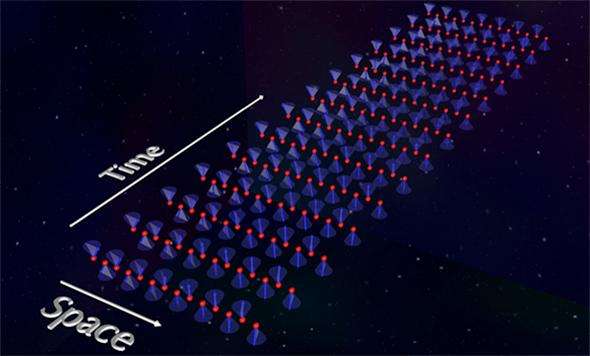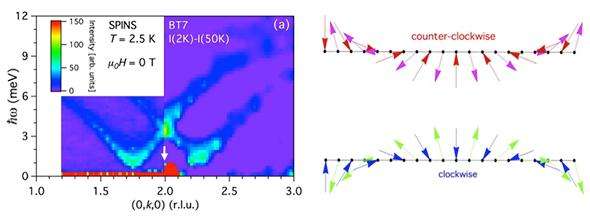Magnon circular birefringence‚ÄĒpolarization rotation of spin waves and its applications

An international team of researchers from Thailand, the U.S. and Japan has conducted a thorough study of an exotic behavior of material called a noncentrosymmetric antiferromagnet. The team, monitoring the behavior of the propagation of spin waves in magnetic material, has reported its findings, which show the first direct evidence of the nonreciprocal magnons.
A circular birefringence effect, in which photons traveling inside a certain kind of crystal have different speeds depending on their circular polarization is fairly common. In other words, left-handed photons might travel faster than right-handed photons. When this effect appears under a finite external magnetic field, it is called the Faraday effect, in which light polarization rotates as it propagates along the crystal with the rotation angle linearly depending on the field. There are useful applications of this effect in modern optical and photonic technologies. Optical isolators use the Faraday effect, whereas magneto-optical recording is based on its reflection variant, the Kerr effect.
Other systems also exhibit behaviors that resemble the circular birefringence effect. In an ordered magnetic material, a spin excitation can also propagate along the crystal. This excitation is called a magnon. Similar to the polarization states of photons, magnons in an antiferromagnet also have two distinct states‚ÄĒleft-circular and right-circular. In most magnetic materials, these two states have the same energy and are therefore indistinguishable. However, in a certain type of magnetic material, these two states of magnons behave differently due to a lack of spatial inversion symmetry in the crystal structure.

This phenomenon, called nonreciprocal magnons, has been predicted by Hayami et al. However, there has been no direct observation of these nonreciprocal magnons until this work. The research team performed neutron scattering experiments on single-crystal őĪ-Cu2V2O7 and observed clear evidence of different energy-momentum dispersion relations between the left-circular and right-circular magnon propagation. The experimental data is confirmed by linear spin-wave calculations.
This new regime of magnetic materials could have applications in magnon-based electronics (magnonics) such as the spin-wave field-effect transistor.
More information: G. Gitgeatpong et al, Nonreciprocal Magnons and Symmetry-Breaking in the Noncentrosymmetric Antiferromagnet, ¬ť∂Ļ“ý‘ļical Review Letters (2017).
Journal information: ¬ť∂Ļ“ý‘ļical Review Letters
Provided by Tohoku University





















